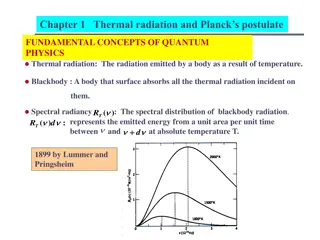Fast Bayesian Optimization for Machine Learning Hyperparameters on Large Datasets
Fast Bayesian Optimization optimizes hyperparameters for machine learning on large datasets efficiently. It involves black-box optimization using Gaussian Processes and acquisition functions. Regular Bayesian Optimization faces challenges with large datasets, but FABOLAS introduces an innovative approach by incorporating subsampled data in the optimization process.
Download Presentation

Please find below an Image/Link to download the presentation.
The content on the website is provided AS IS for your information and personal use only. It may not be sold, licensed, or shared on other websites without obtaining consent from the author.If you encounter any issues during the download, it is possible that the publisher has removed the file from their server.
You are allowed to download the files provided on this website for personal or commercial use, subject to the condition that they are used lawfully. All files are the property of their respective owners.
The content on the website is provided AS IS for your information and personal use only. It may not be sold, licensed, or shared on other websites without obtaining consent from the author.
E N D
Presentation Transcript
Fast Bayesian Optimization of Machine Learning Hyperparameters on Large Datasets AARON KLEIN, STEFAN FALKNET, SIMON BARTELS, PHILIPP HENNING, FRANK HUTTER PRESENTED BY: STEFAN IVANOV
Background Hyperparameter Black-Box Optimization Hyperparameter: A parameter that is set before the learning phase which can substantially affect the performance of the model or algorithm Hyperparameter optimization: Finding a tuple of hyperparameters optimizing a learning algorithm for a specific goal Solving optimization problems of the form: ? = arg ???? X? ? Observe only function values Evaluation of f is expensive Observation may be noisy
Bayesian Optimization Black-box optimization technique involving Gaussian Processes Requires prior over the function being optimized and acquisition function quantifying the utility of evaluation the function at some configuration Prior a Gaussian Process Acquisition functions exploration vs. exploitation Entropy Search (ES) Expected Improvement (EI) Upper Confidence Bound (UCB) Predictive Entropy Search (PES) Positioning of Bayesian optimization among Other black-box optimizers. Image courtesy of [6].
Evaluation of the function optimized can be very expensive Problems with Regular Bayesian Optimization Large datasets required for the performance of the underlying system might even be unoptimizable No notion of good result on a small data set
Fast Bayesian Optimization for Large Data Sets - Idea FAst Bayesian Optimization on LArge data Sets (FABOLAS). Motivation: Human experts study algorithm performance on smaller data sets to determine optimal hyperparameters (i.e. prune bad ones) before using larger sets of data The subsampled data ???? is an additional input to the black box function and the optimizer is free to choose it at each step. However, ???? is not hyperparameter The goal is to optimize performance for ????= ? , i.e. ?(?,?)
Fast Bayesian Optimization for Large Data Sets - Design Environment variable for the model: s =???? ? Changed during optimization but set to 1 during evaluation Extend GP by the extra dimension of ? The FABOLAS algorithm as see in the paper. [1] Encode the behaviour that the loss function of a machine learning algorithm decreases with more data
Alternative Techniques for Hyperparameter Optimization Standard Bayesian Optimization (using Entropy Search or Expected Improvement) Multi-task Bayesian Optimization (MTBO) [5] Optimization for different by correlated tasks Can model the current approach but the number of tasks is discrete and evaluation on the full data set is required for correlation Hyperband [4] Multi-arm bandit strategy Dynamically allocates resources to better performing configurations SMAC (Random forests of regression trees) [3] Extrapolation of learning curves [2] Cancel configurations if after some evaluation time they are deemed to be insufficient
Assessment, I Compared to (1) BO with EI, (2) BO with ES, (3) MTBO and (4) Hyperband Tracked wall clock time relative to validation error Experiments, ML models and data: Support vector machine grid on MNIST Support vector machines on various datasets Convolutional neural networks on CIFAR-10 and SVHN Residual neural network on CIFAR-10 General results Hyperband performs well, if it actually proposes something (could not be used on the last experiment) FABOLAS achieved superior performance when it comes to finding decent parameters quickly SVM hyperparameter optimization on the datasets covertype. [1] All methods converge to a common test error
Test performance of a convolutional neural network on CIFAR10. [1] Test performance of a convolutional neural network on SVHN. [1] Assessment, II
Very little discussion on how the data set is divided for subset evaluation and whether that is important Insufficient comparisons to other methods. In particular, no comparison to Extrapolation of learning curves [2] which showed superior performance to methods in its evaluation Critique Greater performance error in the long run on CIFAR10 is never explained or analyzed The way the environment parameter s (the relative size of the subset evaluated on) is based on evaluation and intuition on one example
[1] A. Klein, S. Falkner, S. Bartels, P. Hennig, F. Hutter: Fast Bayesian Optimization of Machine Learning Hyperparameters on Large Datasets, AISTAS, 2017. [2] T. Domhan, J. T. Springenberg, F. Hutter: Speeding up automatic hyperparameter optimization of deep neural networks by extrapolation of learning curves, IJCAI, 2015. References [3] F. Hutter et al.: Algorithm runtime prediction: Methods & evaluation, Elsevier J. AI, 2014. [4] Li, Lisha, et al.: Hyperband: A novel bandit-based approach to hyperparameter optimization, arXiv preprint arXiv:1603.06560, 2016. [5] K, Swersky, J. Snoek, R. Adams: Multi-task Bayesian Optimization, NIPS, 2013 [6] M. Hoffman: Bayesian Optimization with extensions, applications and other sundry items, UAI 2018, https://youtu.be/C5nqEHpdyoE



















